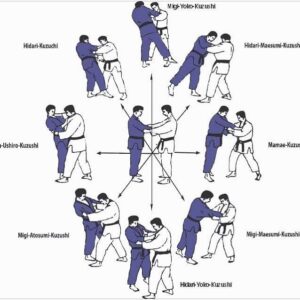Kuzushi (崩し) – Breaking Balance in Judo
In judo, kuzushi—the art of breaking your opponent’s balance—is a foundational concept that enables all throwing techniques (nage-waza). Without effective kuzushi, even the most precise technique will fail.
The Principle of Maximum Efficiency
All judo techniques are grounded in the principle of “Seiryoku-Zenyo” (精力善用)—the most efficient use of energy, both physically and mentally. This principle is expressed in the execution of techniques through the triad:
Kuzushi (崩し) – Breaking the opponent’s balance
Tsukuri (作り) – Fitting in, or getting into position
Kake (掛け) – Execution or completion of the technique
Kuzushi is the first and arguably most critical element of this chain. Without it, tsukuri becomes ineffective, and kake will almost always fail. Judo founder Jigoro Kano emphasized the importance of kuzushi as a prerequisite for efficient technique and safe practice.
“It is not the technique itself that defeats the opponent, but the control of their balance.” – Jigoro Kano
What Is Kuzushi?
The word kuzushi literally means “to demolish” or “to collapse.” In judo terms, it means to disrupt your opponent’s balance or centre of gravity in preparation for a throw. But kuzushi goes beyond a single moment of imbalance—it also includes the prevention of recovery by the opponent (uke). It’s the transitional space where control shifts from uke to tori (the executor of the technique).
Effective kuzushi involves:
Taking away uke’s ability to stand or move freely
Preventing uke from regaining a stable stance
Directing uke’s centre of mass outside their base of support
This can be achieved by pushing, pulling, twisting, or blending with uke’s motion.
Eight Directions of Kuzushi
Kuzushi is not a one-size-fits-all concept. The direction and method of balance breaking depend on multiple factors, including:
The relative distance between tori and uke
The momentum and rhythm of both judoka
The grips being used
The desired technique
As illustrated in the traditional kuzushi diagram, there are eight fundamental directions in which an opponent’s balance can be broken:
Forward (mae)
Forward-right (mae-migi)
Right (migi)
Backward-right (ushiro-migi)
Backward (ushiro)
Backward-left (ushiro-hidari)
Left (hidari)
Forward-left (mae-hidari)
Understanding these directions helps a judoka apply the right kuzushi for each waza, adapting in real-time to uke’s posture and reaction.
Kuzushi Is the Puzzle Piece You Cannot Ignore
Judo techniques are often compared to building a puzzle. Kuzushi is the piece that must be placed first. If it’s missing, the full picture—your throw—can never come together. This is why every judoka, from beginner to expert, must train kuzushi deliberately and with intention.
“Learn to feel your opponent’s balance—not just with your eyes, but with your body.”
